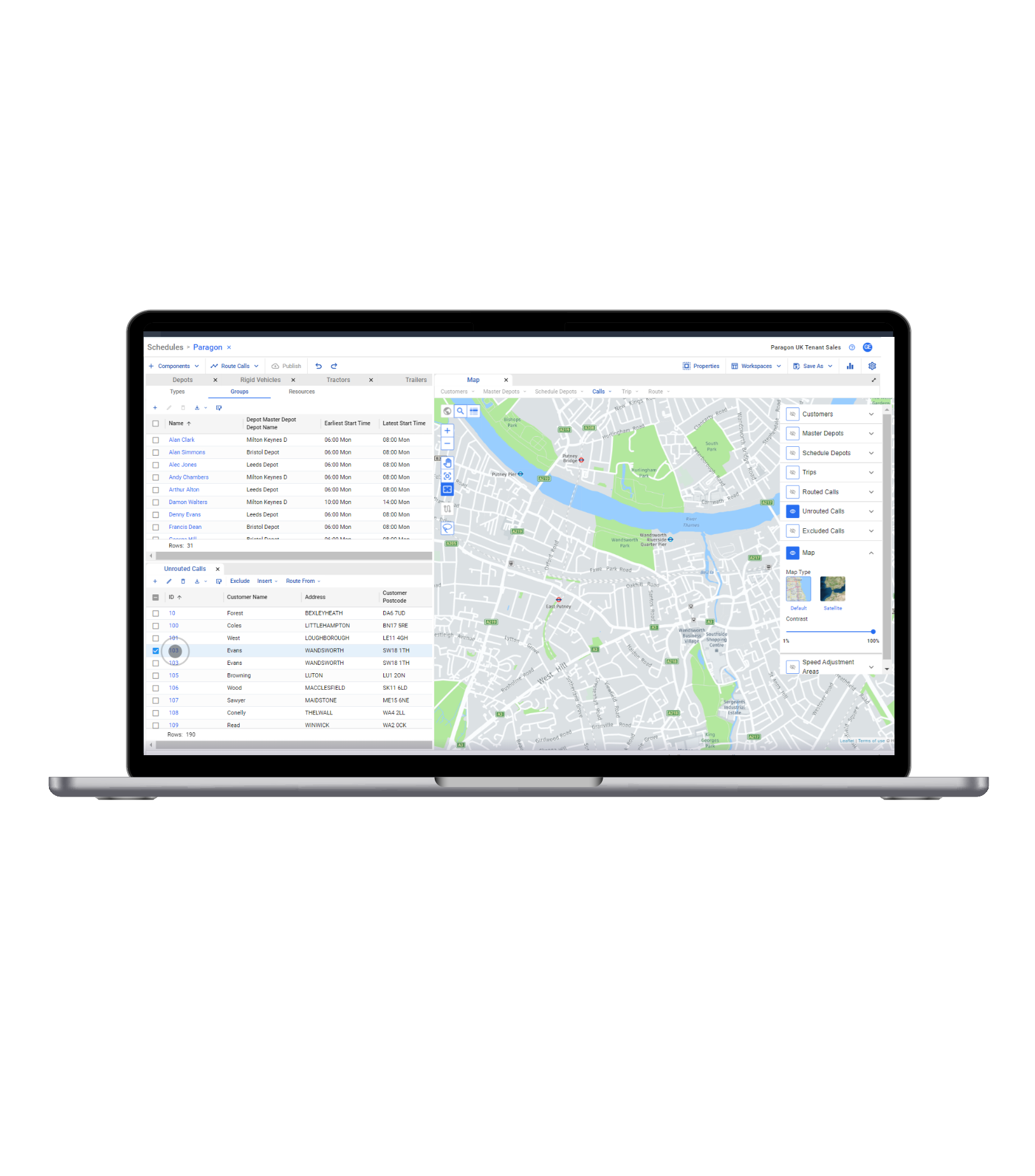5 Mistakes Private Fleet Operators Make and How to Avoid Doing the Same
5 Mistakes Private Fleet Operators Make and How to Avoid Doing the Same
5 Mistakes Private Fleet Operators Make and How to Avoid Doing the Same
15 Sep 2021
 Jim Endres | Regional Account Director
Jim Endres | Regional Account Director
Private fleet companies make up almost half of the $700 billion US trucking industry; 48%, in fact. But while the market size is significant, it’s a highly competitive area, with over 340,000 private fleets currently in operation and numbers still rising.
To thrive in this busy sector, private fleet operators need to focus on efficiency, profitability and outstanding customer service. And learning from these five common mistakes can deliver continuous improvement in all three areas:
1. Sticking to Traditional Routes Because “That’s the Way It’s Always Been Done”
Humans are creatures of habit; we thrive on routine. This can be a good thing for private fleet operators, as planning and dispatch teams are happy to use consistent operational processes. But it can also mean that routes and schedules have evolved over time to fit driver preferences.
For instance: Driver A has a route they prefer, because it goes past their favorite place to stop for lunch. But this decision doesn’t factor in your time and cost to serve customers.
It’s a good exercise to step back and ask yourself why are we scheduling deliveries this way? Is this the most efficient route and best use of our drivers’ time? More often than not, the answer is no. And it’s because everything is being planned and managed on historical decisions and personal preference—rather than using routing software to make strategic, optimized decisions.
2. Omitting Cost of Delivery from Profitability Analysis
While the world has rapidly adopted digital solutions in almost all other areas, many private fleet companies are still reliant on manual planning processes such as pins and strings or sorting paperwork by zip code, or they’re turning to basic or even older routing tools. While these can create a geographical order of preference, they don’t tell you anything about the profitability of your operations.
The route plan itself is only one element in running a profitable logistics company. Data such as the capacity of trucks, whether you’re using driver’s hours of service in full, customer vehicle acceptability, driver skills required, and how long each stop takes can also impact your bottom line.
Capturing and sharing detailed information on a daily basis will help you understand the true cost of delivery, so you can make profit-driven decisions. For example: geographically, Customer A may be the second drop on your route. But Driver A tells you that whenever they turn up at that time, they are detained due to eight trucks already waiting to unload.
With route planning software, you can create a rule which says Customer A’s time window should be at 10-12pm vs. 8-10am. It might mean doing deliveries slightly out of sync an optimal route, but by that time the backlog of trucks has cleared, and Driver A can actually complete more jobs in a day.
3. Forgetting to Involve Sales in Customer Delivery Strategies
Sales teams are focused on targets, which means they’ll promise what is needed to seal the deal. But these promises aren’t always optimal or profitable when it comes to transportation and logistics. Sometimes the most profitable decision for private fleet companies is saying no to a new business opportunity as the cost to serve it too great.
For example: on Driver A’s route, most customers are located within 50 miles of the distribution center. However, a salesperson secures a new customer contract, which involves travelling 40 miles out of route to make a delivery, before returning to finish deliveries closer to home. The new customer only requires a small volume order every week, and they’ve requested a lunch time delivery slot.
In the sales team’s eyes, that new customer is a success, because it brings them one step closer to reaching their quota. But if we return to our previous point about calculating the cost to serve as a key business metric, it makes no sense to add that customer to Driver A’s route.
If logistics personnel are using route optimization technology to plan driver schedules, this information can also be used to enhance sales activity. The software can heat map current customer deliveries, and the sales team can use this data to target businesses in medium or high density areas, to drive new revenue opportunities without dramatically increasing mileage. Subsequently, the sales team may choose to focus their efforts on low volume areas to increase route profitability.
4. Buying Route Planning Software but Not Investing in End User Training
Many private fleet operators that use manual or basic systems to manage logistics are recognizing the need to upgrade to advanced route planning technology. However, route optimization software isn’t always given the same care and attention as ERP or warehouse management systems—and that impacts the business value it delivers.
The biggest opportunity for profitable improvement is delivered by behavioral and organizational change, and that means everyone getting behind the investment; not just the Operations Management and transportation team. Every person in your business needs to back cultural change, starting with an executive sponsor.
It’s also important that investment in digital route planning skills goes beyond the initial roll-out. All too often, private fleet companies will pay for a training program to launch a new system but fail to schedule or invest in ongoing advanced training. As a result, people start to use the software “their way”, rather than adhering to best practice.
We’ve already mentioned the danger of doing things based on personal preference; relying on peer-to-peer training can result in knowledge becoming diluted. And newer users can get frustrated by a perceived lack of functionality within the system, when actually they’re just not using routing software to its full potential.
In addition, private fleet operators need to consider how staff turnover impacts technology ROI. When someone leaves the company, their knowledge leaves with them. So there must be training programs in place for new starters to get up to speed quickly with routing and scheduling software processes.
5. Failing to Evaluate Planned Versus Actual (And Not Including Drivers in the Feedback Loop)
Planning is a critical part of transportation and logistics. But how many private fleet operators are taking the time to analyze the execution of those plans, so you can adapt schedules based on the day-to-day reality of running a complex business?
Today’s vehicle fleets are already equipped with an ELD device to record driving hours, so why not get the maximum use from those systems? Route optimization software can extract this and other data (such as GPS tracking, driver speed information and engine diagnostics) to evaluate your planned routes and deliveries versus actual activity, so you can make continuous improvements.
Another critical part of the improvement loop is involving drivers in performance analysis. We talked earlier about the danger of drivers dictating routes based on preferences, but their on-the-job experience provides value in many other ways.
For example: your sales team secures a contract by promising Customer A that they will always have the first delivery slot of the day, but your GPS data says they’re sometimes third or fourth on the route.
By speaking to your drivers, you find out that the customer has told them they would prefer the first slot, but as long as their delivery arrives before lunch, they’re happy. However, in your routing system, there’s still a rule that they must be first; the route plan is disconnected.
If you’re using routing and scheduling software, you can reconnect your plans with actual knowledge, by removing the rule that stipulates Customer A must always be first on the list. The system then has greater freedom when planning future routes, which contributes to time, fuel and vehicle wear-and-tear savings.
With a smart, digital approach, private fleet companies can strive for operational efficiency and look for ways to eliminate obstacles to optimization. Are you ready?
Aptean Routing & Scheduling Paragon Edition is an advanced route planning, scheduling and tracking solution that is proven to reduce costs, increase efficiencies and improve customer service.
Book your free Aptean Advanced Routing Software demo to find out more.
Tried the Product Tour and Ready to Get Into Gear?
Book your full demo with our team today to see how our advanced routing software can help you accelerate performance.



